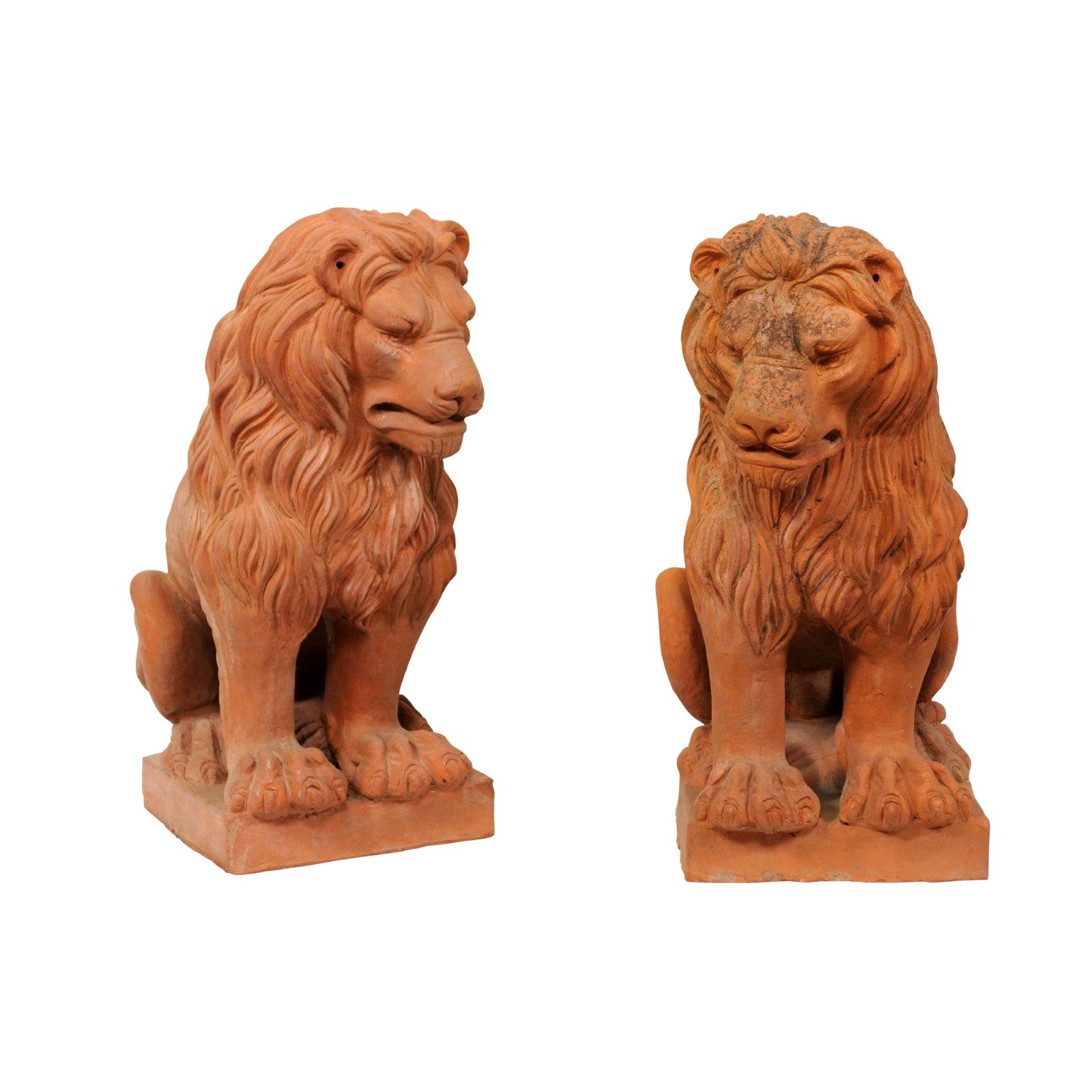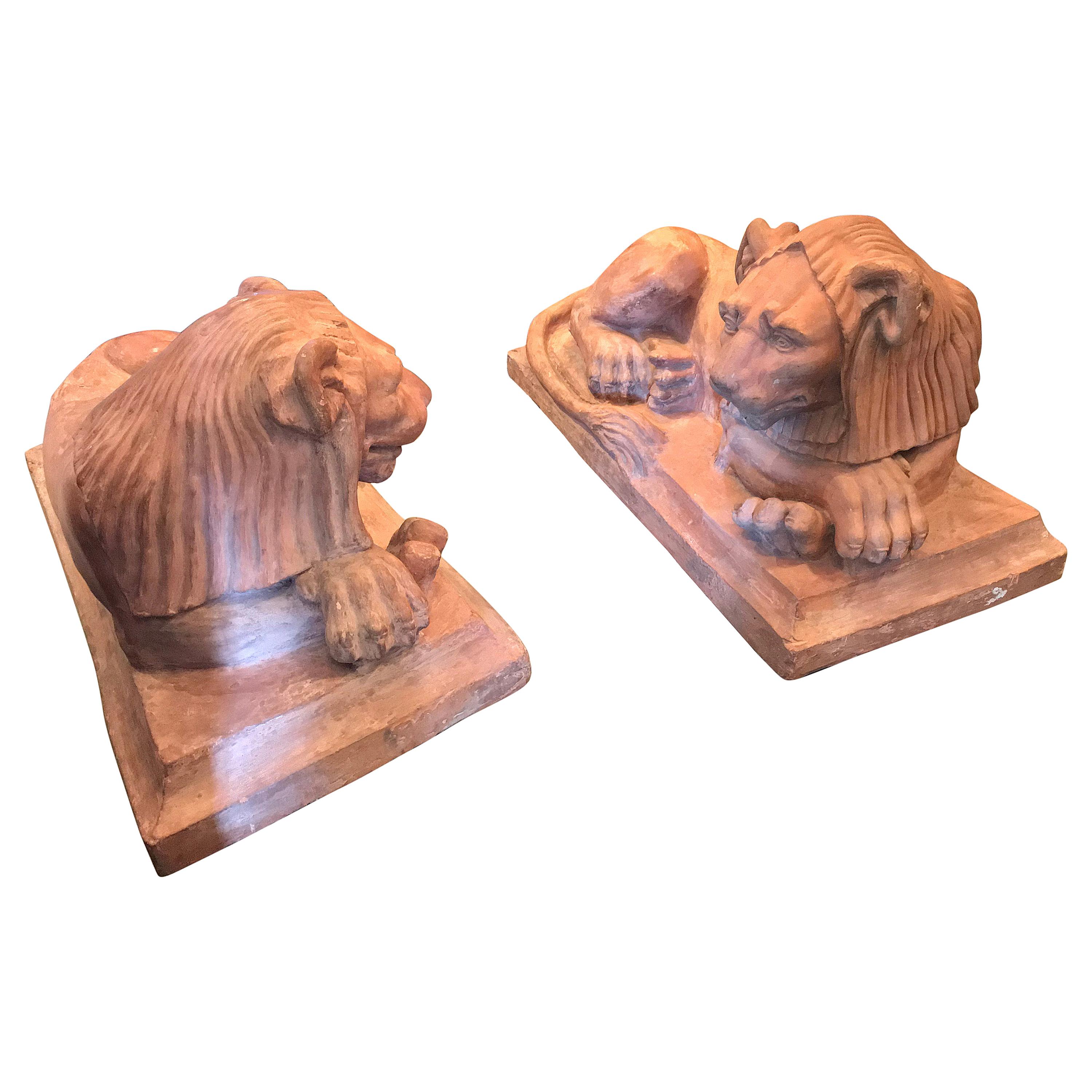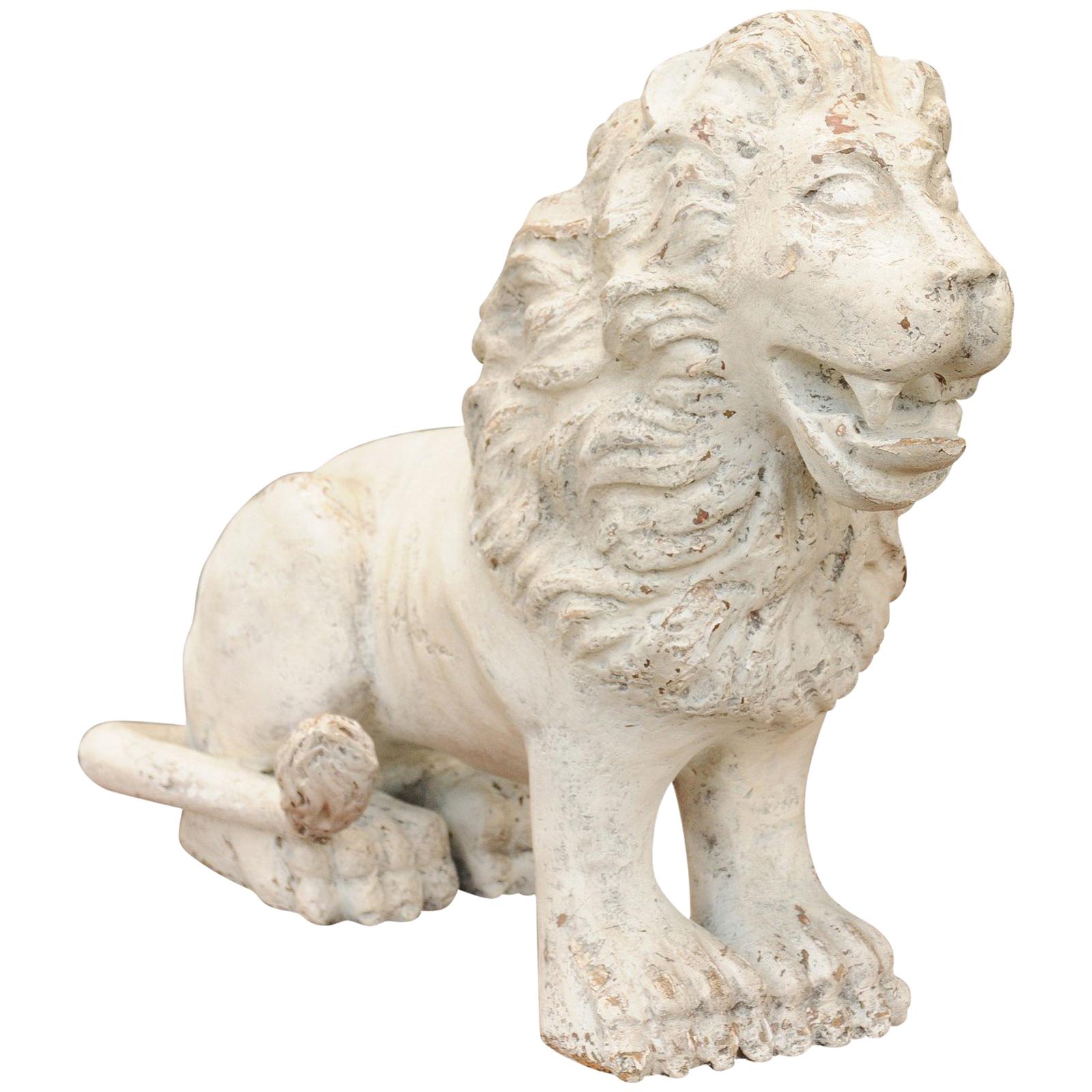Items Similar to Rare Pair of bronze statues of French Lions, 1800s
Want more images or videos?
Request additional images or videos from the seller
1 of 10
Rare Pair of bronze statues of French Lions, 1800s
About the Item
In the soft glow of a dimly lit room, there stands a pair of French statuettes from the enchanting 1800s, a testament to a bygone era of elegance and opulence. These remarkable works of art, fashioned from lustrous bronze, exude an air of timeless grandeur that beckons you to step closer and marvel at their exquisite craftsmanship.
Each statuette is a masterpiece in its own right, a testament to the skill and dedication of the master sculptor who brought them into existence. The attention to detail is nothing short of astonishing, with every sinew of the majestic lions' bodies meticulously chiseled and lovingly rendered. The craftsmanship is so fine that one cannot help but be captivated by the lifelike expressions and powerful stances of these regal creatures.
These two lions, poised in a position of imposing authority, emanate an aura of strength and royalty that transcends time and space. Their heads held high, their fierce eyes gazing into the distance, they embody the very essence of majesty and dominance. Their finely chiseled manes cascade down their muscular necks, a testament to their untamed, wild nature.
But it is not just their form that captivates the beholder; it is the material itself that adds to their allure. Cast entirely in bronze, these lions bear traces of antiquity beneath their paws, a subtle reminder of the centuries that have passed since their creation. The patina of age only enhances their mystique, as if they have borne witness to a thousand stories, silently guarding the secrets of the past.
In symbolism, lions are revered as symbols of strength and royalty, and these statuettes do justice to that legacy. They are more than mere sculptures; they are a declaration of power, a reminder of the grandeur of a bygone era, and a celebration of artistry in its purest form.
These noble creatures, with their resplendent bronze forms, are a perfect complement to any type of furniture, whether modern or classical. They possess a versatility that allows them to seamlessly integrate into various interior styles, yet they never fail to command attention and respect. They are the embodiment of classic elegance, an adornment that can transform any space into a regal sanctuary.
In a world that constantly evolves, these French statuettes from the 1800s stand as a testament to the enduring beauty of artistry and craftsmanship. They are a reminder of the past's timeless allure and an invitation to embrace the majesty and grace that only such exquisite creations can bring into our lives.
- Dimensions:Height: 4.34 in (11 cm)Width: 9.06 in (23 cm)Depth: 2.76 in (7 cm)
- Style:Neoclassical (In the Style Of)
- Materials and Techniques:
- Place of Origin:
- Period:
- Date of Manufacture:1800
- Condition:Wear consistent with age and use. In very good condition.
- Seller Location:Milano, IT
- Reference Number:1stDibs: LU4911236869222
About the Seller
4.8
Platinum Seller
These expertly vetted sellers are 1stDibs' most experienced sellers and are rated highest by our customers.
Established in 2010
1stDibs seller since 2019
337 sales on 1stDibs
Typical response time: 2 hours
- ShippingRetrieving quote...Ships From: milano, Italy
- Return PolicyA return for this item may be initiated within 1 day of delivery.
More From This SellerView All
- Italian Sicilian wood briar Italian chest of drawers late 1800sLocated in Milano, ITAllow me to transport you to the exquisite world of antique Sicilian craftsmanship with a late 1800s dresser that encapsulates the essence of Italian ar...Category
Antique 1890s Italian Neoclassical Commodes and Chests of Drawers
MaterialsWood
- Bronze Statue Hans Peisser and Pankraz Labenwolf, Attributed to, WarriorLocated in Milano, ITThe bronze statue depicts a Turkish warrior with shield and sword. the warrior is shown bare without veils, with a base also made of oval-shaped bronze, acting in a war scene. Detai...Category
Antique 16th Century German Renaissance Figurative Sculptures
MaterialsBronze
- Pair of Dog-shaped bookends made of onyx and bronzeLocated in Milano, ITWonderful pair of Italian Baroque paperweights from the 1800s. The pair is made with a truly binding Onyx base. The onyx stone has been carved to make the paperweights semi-equal. Ab...Category
Antique 1870s European Baroque Desk Sets
MaterialsOnyx, Bronze
- Statue Balinese figure of a seated Hindu priestLocated in Milano, ITIn the heart of Bali, amidst the lush tropical landscapes and the whispers of ancient traditions, stands a mesmerizing wooden statue that tells a tale of devotion and serenity. This ...Category
Antique Early 1900s Thai Anglo-Indian Figurative Sculptures
MaterialsTeak
- Boulle-styled panelled desk Napoleon IIV, late 1800s in bronzeLocated in Milano, ITBehold the exquisite beauty of an antique Boulle-style desk from the late 1800s, a true masterpiece that once graced the era of Napoleon III. This desk is not just a piece of furnitu...Category
Antique 1880s French Napoleon III Desks and Writing Tables
MaterialsBronze, Brass
- Silk fan in shrine from the late 1800sLocated in Milano, ITThe Italian silk fan in a vitrine from the late 1800s is a true masterpiece of craftsmanship and elegance. Housed in a beautiful alloy case, this antique fan...Category
Antique 1890s Italian Neoclassical Decorative Art
MaterialsSilk, Wood
You May Also Like
- 1800s Lead Garden StatueLocated in Peekskill, NYThis is a 20 inch statue of a child holding a flame. The sculpture mislead and surprisingly heavy for its size. The patina is beautiful.Category
Antique Late 19th Century Unknown Baroque Figurative Sculptures
MaterialsLead
- Pair of French Vintage Terracotta Snarling Lion StatuesLocated in Atlanta, GAA pair of French vintage terracotta lions. This pair of lions from France, standing approximately 2 feet in height, each feature abundantly fl...Category
20th Century French Statues
MaterialsTerracotta
- Antique Pair of Hand-Made French Reclining Lion StatuesLocated in Los Angeles, CATruly one of a kind pair of old handmade reclining lions. These are unsigned and used a mixture of clay and fiberglass fibers. They show very heavy signs of loss over the years b...Category
Antique 19th Century French Baroque Animal Sculptures
MaterialsClay, Fiberglass
- Vienna Bronze, Red Robin, Austria Late-1800sBy GeschutztLocated in PARIS, FRSuperb red robin Vienna bronze with beautiful polychrome colours, Austria 19th century. Stamped Geschützt. In good condition. Dimensions in cm ( H x L x l ) : 7 x 11 x 4...Category
Antique Late 19th Century Austrian Romantic Animal Sculptures
MaterialsBronze
- Rare Pair French Retour D'egypt Terracotta Lions Sculptures Statues Los AngelesLocated in West Hollywood, CAExceptional fine and rare pair of French Retour D'egypt period terracotta lions, circa 1790-1810. The French Egyptian Revival style or the retour d'Egypte refers to style that makes use of the motifs and imagery of ancient Egypt. By the end of the 18th century enthusiasm for ancient Egypt generated by Napoleon's unsuccessful conquest of Egypt and, in Britain, to Admiral Nelson's defeat of Napoleon at the Battle of the Nile in 1798. Napoleon took a scientific expedition with him to Egypt and this was the first time a major study of ancient Egypt was done. Publication of the expedition's work, the description de l'Égypte, began in 1809 and came out in a series though 1826 influencing a new way of life in France thru architecture and decorative arts. However, works of art, decorative arts, furniture and, in the field of architecture and garden follies, funerary monuments in the Egyptian style had appeared in scattered European settings from the time of the Renaissance. The Egyptian Revival style came out in a few waves in France before Napoleon during the ancient Régime Egyptian motifs were mixed with the neoclassical-Louis XVI style in architecture, furniture and decorative arts. A big surge hit France around 1798 during Napoleons Egyptian expedition. This was the first major Egyptian Revival period as this was the first time in history that a major study on Egypt was done. French people became fascinated with the ancient Egyptian history, culture, architecture and furniture. Egyptian ornamentation like scarab beetles, sphinxes, winged lions and lotuses details were incorporated into Classical style furniture and decorative arts creating a style known as a hybrid neo-Egyptian. The next wave was during the height of the French Romantic period 1820s-1850s. The Egyptian Revival emerged as a result of the famous archaeological digs of the first half of the 19th century and was primarily used for Tomb memorials, temples, and cemeteries and some decorative arts. This style is distinguished by its adaptation of Egyptian forms and motifs, sphinxes guarding buildings including lotus blossoms, Pharaoh's heads, the winged disk symbol of the sun God, as well as the use of bold bright colors. At the end of the 19th century 1870s-1890s the Egyptian Revival styles were in vogue once more. At the Height of the Victorian period the Egyptian style was even more elaborate than before. Often incorporated with Neo-Greek & Renaissance Revival styles. Victorians were even more fascinated with these rare finds and incorporated their motifs into jewelry, furniture, glass and Art pottery. Heavily ornamented overstuffed furniture...Category
Antique Late 18th Century French Statues
MaterialsTerracotta
- Italian Carved and Painted Wooden Sculpture of a Lion from the Early 1800sLocated in Atlanta, GAAn Italian carved and painted wood lion from the early 19th century. How not to be charmed by this exquisite painted lion, who almost seems to be smiling? The sculpture mixes a touch...Category
Antique Early 19th Century Italian Animal Sculptures
MaterialsWood
Recently Viewed
View AllMore Ways To Browse
Animal Statue For Garden
Monkey Skull
Bosse Dachshund
Delphin Home
Carved Wood Fish Sculpture
Terracotta Blanc De Chine
Man Bites Dog
Murano Blue Rooster
Animal Claws
Hand Carved Pipes
Bronze Hunting Relief
Porcelain Dog Turquoise
Gold Animal Motif Charms
Cold Painted Terracotta
Murano Bunny
Murano Glass Bunny
Porcelain Poodle Dog
Seguso Nero





